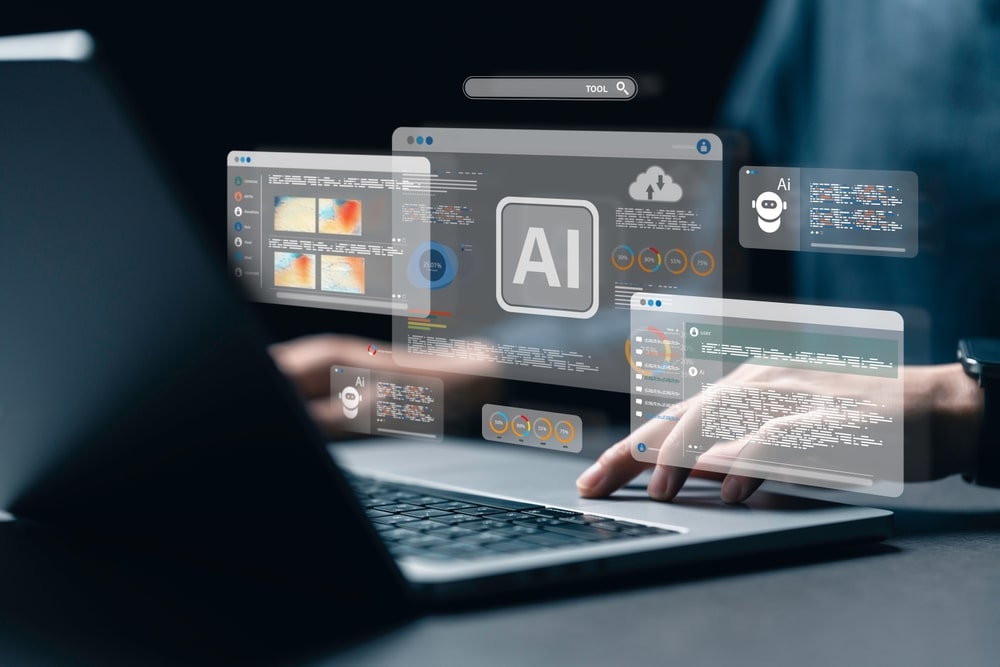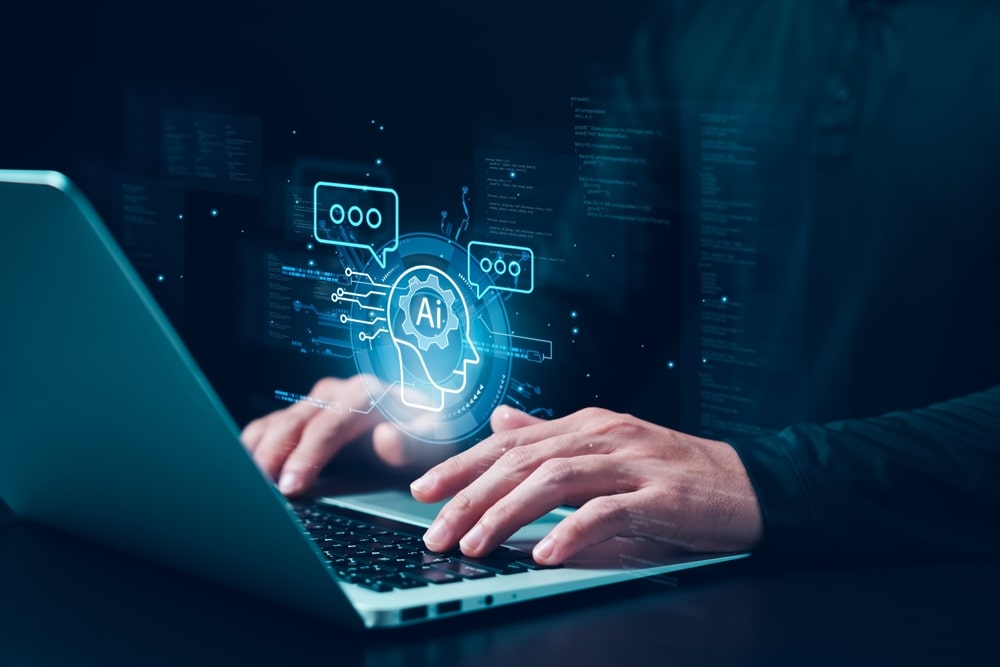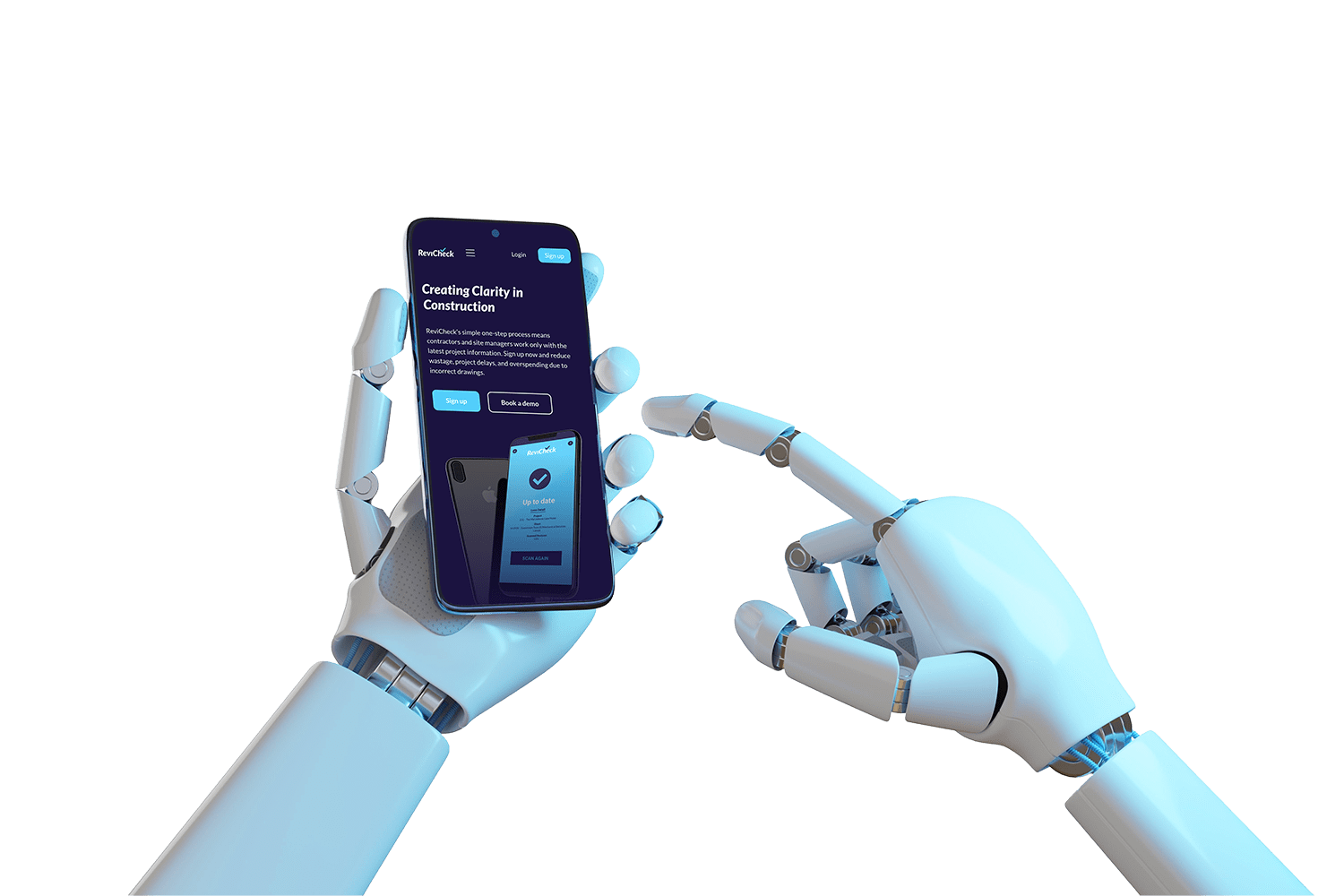Artificial Intelligence (AI) refers to the simulation of human intelligence in machines that are programmed to think and learn like humans. It encompasses a broad spectrum of technologies and approaches aimed at creating intelligent systems capable of performing tasks that traditionally require human intelligence. The ultimate goal of AI is to enable machines to mimic cognitive functions such as problem-solving, learning, reasoning, perception, and language understanding.
At its core, AI involves the development of algorithms and models that allow machines to process information, recognise patterns, and make decisions in a way that imitates human thought processes. These algorithms are designed to analyse large datasets, extract meaningful insights, and adapt to changing circumstances, allowing AI systems to improve their performance over time.

These algorithms and models are being used more and more in the website design industry as we discuss below.
AI in Website Design
In the realm of website design, Artificial Intelligence (AI) represents a transformative force that uses computational power to enhance user experiences, automate development processes, and optimise overall performance. AI in website design involves the integration of intelligent algorithms and technologies to create websites that not only look visually appealing but also adapt and respond to user behaviours in real-time.
AI in website design represents a dynamic synergy between human creativity and machine intelligence, aiming to deliver a more personalised, efficient, and user-centric online experience. As technology continues to evolve, the role of AI in shaping the future of web design will undoubtedly expand, offering exciting possibilities for innovation and improvement.

Examples of Artificial Intelligence in Website Design
Several examples showcase the impactful integration of AI in website design, transforming static platforms into dynamic, responsive, and personalised environments.
Chatbots
Chatbots with Artificial Intelligence (AI) have emerged as powerful tools in website design, fundamentally transforming the way businesses engage with their online audience. These intelligent conversational agents use advanced algorithms and natural language processing capabilities to interact with users in real-time, providing instant assistance and information. The integration of AI-driven chatbots into website design enhances user experience, fosters customer engagement, and contributes to overall efficiency.
One primary function of AI-powered chatbots in website design is to provide immediate and automated customer support. These chatbots can understand user inquiries, address frequently asked questions, and guide users through various processes, offering a seamless and responsive support channel. This not only improves user satisfaction but also enables businesses to handle a larger volume of inquiries efficiently, 24/7.
Personalisation is a key aspect of AI-driven chatbots. These bots analyse user data, preferences, and behaviour to deliver tailored responses and recommendations. For example, an ecommerce website’s chatbot can suggest products based on a user’s browsing history, creating a personalised shopping experience. This level of customisation enhances user engagement and increases the likelihood of conversions, incredibly beneficial to ecommerce stores.

Moreover, AI-powered chatbots contribute to the analysis of users’ feelings, allowing businesses to gauge user satisfaction and gather valuable feedback. Through natural language understanding, these bots can detect the tone and sentiment of user messages, helping companies identify areas for improvement and refine their products or services based on user input.
Despite the numerous advantages, the implementation of AI-driven chatbots requires careful consideration of ethical concerns. Businesses must ensure transparency in communicating that users are interacting with a bot and prioritise user privacy. Additionally, efforts should be made to minimise biases in the algorithms to deliver fair and inclusive interactions.
Chatbots with AI in website design represent a transformative leap in user interaction and engagement. From enhancing customer support to personalising user experiences, these intelligent agents contribute to the efficiency and effectiveness of online platforms.
Ecommerce
Artificial Intelligence (AI) has become a cornerstone in the evolution of ecommerce, revolutionising the way businesses operate, interact with customers, and optimise their processes. The integration of AI in ecommerce has led to a myriad of innovative applications that enhance user experiences, streamline operations, and drive business growth. Here are several examples illustrating the transformative impact of AI in the realm of ecommerce.

AI algorithms analyse vast amounts of user data, including browsing history, purchase behaviour, and preferences, to generate highly personalised product recommendations. Ecommerce giants like Amazon leverage AI to offer customers suggestions based on their past interactions, creating a tailored shopping experience. This not only increases the likelihood of successful conversions for ecommerce businesses but also enhances customer satisfaction by presenting relevant and appealing products.
As discussed, AI-powered chatbots are employed to provide instant and automated customer support. These chatbots, equipped with natural language processing capabilities, can understand user queries and provide relevant information in real-time. Ecommerce platforms utilise chatbots to assist customers with product inquiries, order tracking, and issue resolution, offering a responsive support channel that operates 24/7.
For store owners, AI algorithms can assist to implement dynamic pricing strategies based on real-time market conditions, demand, and competitor pricing. This allows ecommerce owners to optimise pricing for maximum profitability while remaining competitive. Airlines and hotel booking platforms, for instance, adjust prices dynamically based on factors like demand, seasonality, and availability, ensuring optimal revenue generation.
The examples of AI in ecommerce showcase a landscape where data-driven insights and intelligent automation play pivotal roles in shaping user experiences and driving business success.
Website Design Tools
AI-powered website design tools leverage advanced algorithms and machine learning to automate various aspects of the design process, enhancing both the speed and quality of website development.
One key aspect of AI in website design tools is automated layout suggestions. These tools analyse design trends, user preferences, and industry standards to generate intelligent suggestions for website layouts. By understanding the principles of design and user experience, AI can propose aesthetically pleasing and well-balanced layouts that serve as a solid foundation for further customisation. This not only accelerates the design process but also assists designers in maintaining a visually appealing and user-friendly interface.
Content creation and generation represent another frontier where AI excels in website design. AI tools can analyse existing content, user behaviour, and industry trends to generate compelling and relevant text. This feature is particularly useful for creating product descriptions, blog posts, and other textual elements of a website. Not only does this streamline the content creation process, but it also ensures that the content aligns with SEO best practices and user expectations.

AI-powered website design tools also contribute to the optimisation of user interfaces (UI) and user experiences (UX). Through data analysis and machine learning, these tools can evaluate user interactions and suggest improvements to enhance navigation, reduce friction, and optimise conversion paths. This iterative process of refinement ensures that the website continually evolves to meet user needs and preferences.
In addition to the creative aspects of design, AI tools play a crucial role in website performance optimisation. These tools analyse data on user behaviour, device types, and browsing habits to optimise page load times, ensuring a seamless and responsive experience for visitors. By identifying and addressing performance issues, AI contributes to a positive user experience and helps in achieving better search engine rankings.
While AI website design tools offer numerous benefits, the oversight of a human while creating the website remains essential. We believe that business owners shouldn’t create a website with just an AI website builder and you can read more about this topic in our article: Can you create a website with just an AI Website Builder?.
Benefits of AI in Website Design
The integration of Artificial Intelligence (AI) into website design can lead to many benefits, transforming the landscape of digital experiences for both businesses and users. From enhanced efficiency in development processes to the creation of more personalised and engaging interfaces, the advantages of incorporating AI in website design are substantial.
Efficient Design Processes
One of the primary benefits of AI in website design is the automation of repetitive tasks, allowing designers to focus on more strategic and creative aspects. AI-powered tools can generate layout suggestions, recommend colour palettes, and even automate the coding of certain design elements. This streamlines the design process, significantly reducing the time and effort required to create visually appealing and functional websites.
Personalised User Experiences
AI algorithms analyse user behaviour, preferences, and historical data to deliver personalised experiences. This personalisation extends to content recommendations, product suggestions, and even the overall design of the website. By understanding individual user needs, AI ensures that each visitor is presented with content and features that are relevant and tailored to their interests, fostering a deeper connection between users and the website.
Responsive and Adaptive Design
AI plays a crucial role in creating responsive and adaptive designs that cater to various devices and screen sizes. Through data analysis, AI tools can optimise the layout and content presentation based on the user’s device, ensuring a consistent and seamless experience across desktops, tablets, and smartphones. This responsiveness is essential for reaching a diverse audience and accommodating the evolving landscape of digital devices.
Data-Driven Decision Making
AI empowers designers with valuable insights derived from data analysis. By examining user interactions, preferences, and trends, AI provides data-driven recommendations for design improvements. This iterative approach allows designers to make informed decisions, optimising UI/UX elements to align with user expectations and behaviours. Data-driven insights also contribute to the continuous improvement of the website over time.

Improved User Engagement
AI enhances user engagement by facilitating interactive features such as chatbots, virtual assistants, and personalised recommendations. Chatbots powered by AI provide instant customer support, guiding users through the website and addressing queries in real-time. Personalised recommendations based on user preferences not only increase the time users spend on the site but also contribute to higher conversion rates, as visitors discover relevant products or content.
Enhanced SEO and Content Optimisation
AI aids in optimising website content for search engines. Content creation tools powered by AI can generate SEO-friendly text, ensuring that websites rank well in search engine results. Additionally, AI helps in analysing keyword trends, user search patterns, and competitor strategies, allowing designers to make informed decisions about content creation and optimisation.
Dynamic A/B Testing
A/B testing is a crucial aspect of website optimisation, and AI makes this process more dynamic and effective. AI algorithms can analyse A/B test results in real-time, identifying patterns and trends that may not be immediately apparent. This enables designers to iterate quickly and implement changes that lead to improved user engagement and conversions.
Cost Efficiency
While initially requiring an investment in AI technologies, the long-term benefits of incorporating AI in website design include cost efficiency. Automation of tasks reduces the time and resources needed for development, maintenance, and updates. This cost-effective approach allows businesses to allocate resources more strategically, focusing on innovation and growth.

Disadvantages of AI in Website Design
While the integration of Artificial Intelligence (AI) into website design offers numerous advantages, it is essential to acknowledge and address the potential disadvantages associated with this advanced technology. As AI continues to evolve, certain challenges and drawbacks may arise, impacting various aspects of the website design process and user experiences.
- Overreliance on Automation: One of the primary disadvantages of AI in website design is the risk of overreliance on automation. While Artificial Intelligence can automate repetitive tasks and streamline processes, an excessive dependence on automation may lead to a lack of human creativity and intuition in design decisions. Designers should maintain a balance between AI-driven automation and their own expertise to ensure the uniqueness and innovation of the design.
- Lack of Emotional Intelligence: AI lacks the emotional intelligence that human designers possess. While AI algorithms can analyse data and user behaviour, they may struggle to comprehend or respond to the emotional nuances that influence user preferences. Designing for emotional impact, which is crucial in creating memorable and engaging websites, requires a human touch that AI may not fully replicate.
- Ethical Considerations and Bias: AI systems are only as unbiased as the data they are trained on. If the training data contains biases, the AI may inadvertently perpetuate or amplify these biases in the design recommendations. Designers must be vigilant in ensuring that AI-driven tools and algorithms are ethically designed and do not unintentionally introduce or reinforce biases related to gender, race, or other sensitive factors.
- Complex Implementation and Maintenance: Implementing AI in website design requires a certain level of technical expertise. Small businesses or designers without the necessary resources may find it challenging to integrate and maintain AI-driven tools effectively. Additionally, frequent updates and maintenance are essential to keep AI systems optimised, which can pose challenges for organisations with limited technical capabilities.
- Limited Understanding of Context: AI algorithms may struggle to understand the broader context or intent behind certain design choices. While they can analyse data and patterns, they may lack the contextual understanding that human designers bring to the creative process. This limitation may result in design recommendations that do not align with the overall vision or goals of a website.
- Privacy Concerns: AI tools often rely on vast amounts of user data to personalise experiences and make design recommendations. Privacy concerns may arise as users become more aware of how their data is being utilised. Designers must prioritise user privacy and ensure that AI applications adhere to data protection regulations to maintain trust and transparency.
- Complex Decision-Making: The complexity of AI decision-making processes may be challenging for designers to interpret and understand fully. This can create a disconnect between the design recommendations generated by AI and the human designers responsible for implementing them. Clear communication and collaboration between designers and AI systems are crucial to navigating this potential drawback.
While AI offers powerful capabilities for website design, it is important to be aware of its limitations and potential disadvantages.
In summary
Summing up, the integration of Artificial Intelligence (AI) in website design represents a transformative shift, offering unparalleled efficiency, personalisation, and data-driven insights. While AI enhances automation and optimises user experiences, designers must navigate challenges such as ethical considerations, potential biases, and the need for a human touch in creative decision-making. Striking a balance between the capabilities of AI and the unique insights of human designers ensures the realisation of innovative, user-centric websites. As technology evolves, the collaboration between AI and human creativity will continue to shape the future of website design, setting new standards for digital excellence.




